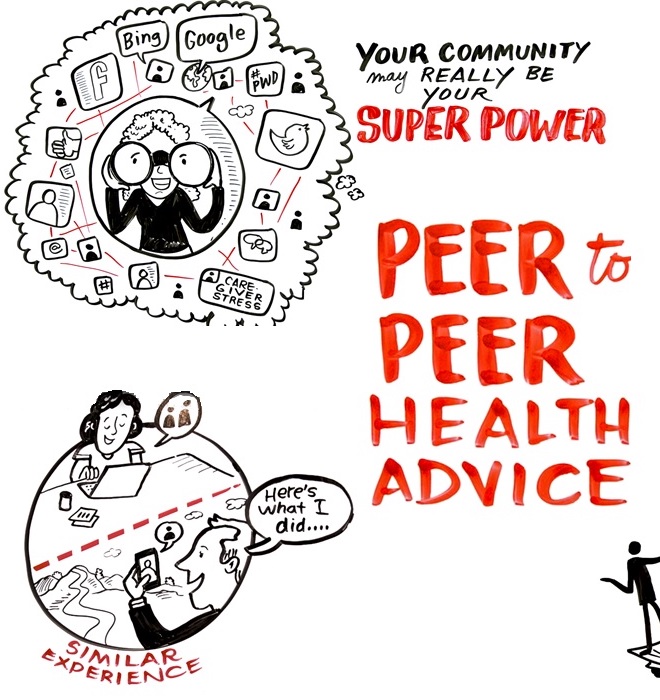
Dr. Joe Kvedar interviewed me for his podcast, Well/Connected, and I thought I’d share footnotes for all the resources I mentioned.
- Key findings from the national survey of 14- to 22-year-olds focused on digital health and social media use, sponsored by Hopelab and Well Being Trust, which took a special look at people living with moderate to severe depressive symptoms:
- 90% of U.S. teens and young adults living with depressive symptoms say they have gone online for information on mental health issues (compared to 48% of those without depressive symptoms).
- 76% of U.S. teens and young adults living with depressive symptoms say they have used health-related mobile apps (compared to 58% of those with no symptoms). Nearly four in ten (38%) say they have used apps related to mental well-being, such as meditation, stress reduction, and depression.
- Teens and young adults with moderate to severe depressive symptoms report having heightened responses to social media – both positive and negative—than those without symptoms of depression.
- Full report: Digital Health Practices, Social Media Use, and Mental Well-Being Among Teens and Young Adults in the U.S., by Victoria Rideout, M.A. and Susannah Fox.
- Peer to peer health care emerged as one of the most important trends I uncovered in my research while working at the Pew Research Center. See:
- “Peer-to-peer Healthcare.” (Pew Research Center. February 28, 2011.)
- “After Dr. Google: Peer-to-Peer Health Care.” (Journal of the American Academy of Pediatrics. Vol. 131 No. Supplement 4 June 1, 2013; pp. S224 -S225).
- Sources of Health Information Among People Living with Chronic Conditions (Pew Research Center. November 26, 2013.)
- “The Social Life of Health Information.” (Pew Research Center. January 2014.)
- Video: Peer health advice (Produced in partnership with Reframe Health Labs, sponsored by the Robert Wood Johnson Foundation. 2017.)
- Working at the national level, as CTO at HHS, broadened my view of the potential for peer-to-peer connection. I saw how important it is for entrepreneurs inside a federal agency to connect with each other, such as through the Ignite Accelerator or when Entrepreneurs- and Innovators-in-Residence would trade ideas about navigating the bureaucracy.
- The Hopelab/Well Being Trust study allowed me to take a new measure of peer-to-peer health care among teens and young adults:
- 39% of U.S. teens and young adults say they have gone online to try to find people with health conditions similar to their own, using methods such as participating in online forums or closed social media groups on specific issues, doing hashtag searches on social media, or following people with similar health conditions.
- One third (33%) of U.S. teens and young adults have successfully connected with health peers online, and 91% of them say the experience was helpful.
- My initial focus on peer connection was guided by Tom Ferguson, MD, who believed that clinicians should play the role of coach, helping people to connect with the information, data, and tools they need to solve their own problems. That remains my guiding principle and has expanded to encompass a view of a wide spectrum of engagement, from citizen-scientists hacking their microbiome to the people trading health advice in product reviews on Amazon.
- There’s also a spectrum of engagement in self-tracking, from paper & pencil to very technical mechanisms. We in health care should not assume that we know where someone is along that spectrum, nor how it will change if they are diagnosed with a serious condition or experience some other trigger in their lives.
- We should open access to data wherever it exists: at the individual level, practice level, system level, national level.
- Blue Button is an example of opening access to individual-level data. The HHS Data Initiative is an example of national-level data.
- I argue for the use of a “wheat” analogy for data rather than “data as oil.”
- There is a perception of a lack of engagement, when in fact people are carrying so much in their lives that health care doesn’t recognize as part of health: the Unmentionables (shout out to Alexandra Drane, who created this concept). (And I should have mentioned Erin Moore’s immortal insight: “I hate term ‘patient engagement.’ No one is more engaged, involved than the patient. I want researcher, clinician, industry engagement.”)
- A ray of hope for me are the two-thirds of teens and young adults who use health apps, many of whom are using apps to nurture their physical and emotional well-being. How might we increase our connection to each other, our connection to our own humanity, through digital tools?
Here’s the link to listen to my interview and a list of all the Well/Connected episodes. Please let me know if it sparks questions!
Following up on my comment above about peer to peer among entrepreneurs, check out this New York Times article about startup founders finding community with others who want to grow their businesses without venture capital investment. The way the reporter describes the meeting reminds me of both patient groups that want to create change outside the traditional health care system AND the conversations we’d host at HHS among people who wanted to create change outside the traditional bureaucracy. Fascinating!